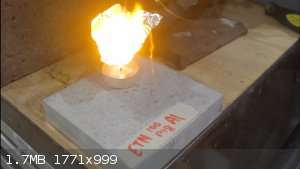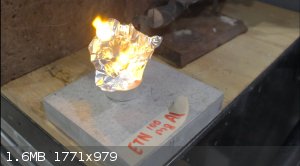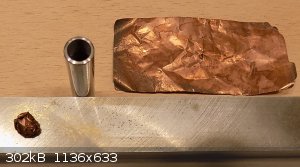| Pages:
1
..
3
4
5 |
Hey Buddy
Hazard to Others
  
Posts: 441
Registered: 3-11-2020
Location: Bushwhacker Country
Member Is Offline
|
|
double post. oops
[Edited on 23-11-2022 by Hey Buddy]
|
|
|
Hey Buddy
Hazard to Others
  
Posts: 441
Registered: 3-11-2020
Location: Bushwhacker Country
Member Is Offline
|
|
Initial investigation into ETN DDT phenomenon.
Tested heating of ETN on foil in effort to incite DDT. ETN was homogenous casted ETN, broken into chunks.
Samples were heated from underneath. Different foil materials with a range of random thicknesses were selected. Heating was done by open flame of
consumer "tea candles".
This initial test was simply to get an idea of broad behavior of ETN DDT on foil.
Two tests were carried out for each foil type with repeated results.
DDT in ETN may not be induced directly by conduction, but rather by something more complex. There may be a molecular material interaction or a result
of emissivity or some other intrinsic property within materials. Results of this test were unexpected and inform design of additional testing.
Al foil, unconfined -Deflagration
"Always Save"
0.004 mm (Very thin)
ETN 100 mg
 
Ni foil, unconfined -Deflagration
0.05 mm (Very Heavy)
ETN 100 mg
 
Cu Foil, unconfined -Detonation
0.02 mm (Heavy)
ETN 100 mg
 
[Edited on 23-11-2022 by Hey Buddy]
|
|
|
MineMan
International Hazard
    
Posts: 1013
Registered: 29-3-2015
Member Is Offline
Mood: No Mood
|
|
Wow Hey Buddy! So it’s more reactive with Cu!! Again making the case for adding nano or micron Cuoxide in DDT ETN formulations
|
|
|
B(a)P
International Hazard
    
Posts: 1139
Registered: 29-9-2019
Member Is Offline
Mood: Festive
|
|
Quote: Originally posted by MineMan  | | Wow Hey Buddy! So it’s more reactive with Cu!! Again making the case for adding nano or micron Cuoxide in DDT ETN formulations
|
Or the copper transferred the heat from the flame to the ETN the fastest/most efficiently, though the additional thickness of the copper foil does
make this less likely. Was there a noticeable difference in the time to detonation/deflagration from when the heat was applied? Another test would be
use a consistent material with flames of differing power. Something along the lines of heat gun vs candle vs gas match vs butane torch. I might give
this a go myself.
All very interesting stuff!
|
|
|
Laboratory of Liptakov
International Hazard
    
Posts: 1409
Registered: 2-9-2014
Location: Technion Haifa
Member Is Offline
Mood: old jew
|
|
Aluminium is not condition for DDT.
Alu foil is only popular for his easy availability. Thin Cu foil 0.02 mm on pic. Is possible obtain from Li- Po acumulators. (Also is possible use
for soldering hermetic thin plugs)

Development of primarily - secondary substances CHP (2015) Lithex (2022) Brightelite (2023) Nitrocelite and KC primer (2024)
|
|
|
Hey Buddy
Hazard to Others
  
Posts: 441
Registered: 3-11-2020
Location: Bushwhacker Country
Member Is Offline
|
|
Quote: Originally posted by B(a)P  | | Was there a noticeable difference in the time to detonation/deflagration from when the heat was applied? |
In this test the method of heat application wasnt controlled enough to eliminate influences from heat applied over time, but in general it was about
the same time from heat application to reaction. I tried to standardize it reasonably by using tea candles that were all the same. I dont think tea
candles are consistent enough but I dont think the heating rate had an effect on whether ETN DDTd or Burned. Each was was very slow to occur, and was
preceded by melting and off gassing before decomp. Im recording all these tests and will compile them all into an ETN behavior video once enough tests
are done.
-- My hunch was definitely shifted. I believed before the test, ddt was a simple factor of conductive heating of a materials surface. I believe now it
is dependent upon a material property, such as the materials ability to pass heat/hold heat, and I am reluctantly leaning more than before, into the
idea that a molecular interaction between ETN and the material is happening. More tests are needed but Im thinking about it...
|
|
|
MineMan
International Hazard
    
Posts: 1013
Registered: 29-3-2015
Member Is Offline
Mood: No Mood
|
|
Next. Try ETN with 20 percent Al on the copper foil. Perhaps NPED will be easy with the addition of copper powder in ETN
|
|
|
Hey Buddy
Hazard to Others
  
Posts: 441
Registered: 3-11-2020
Location: Bushwhacker Country
Member Is Offline
|
|
ETN DDT TEST PART II
Follow up test looking for molecular interaction.
The same materials from previous test were fluxed together using zinc chloride flux smeared between foils, then foils pressed flat.
Samples included Al/Cu, Al/Ni, Cu/Al, Cu/Ni, Ni/Al, Ni/Cu. The first material in each material pair is the material top side, in contact with ETN, the
2nd material listed in each material pair is on the bottom side and in contact with the open flame of a tea candle. Times required until reaction
seemed not to have any relation to DDT probability and were all reasonably similar. Visible color change of samples as they melted was observed. All
samples turned darker and yellow and produced a reddish hue on melting. This melt>boil>red hue>react was observed for both DDTs and
deflagrations.
Results were again surprising, ETN seemed to revert back to DDTing semi-unpredictably. There did seem to be a greater occurrence of DDT in materials
with Cu foil present, but this test needs to be repeated several times in attrition to reveal any meaningful pattern.
Two tests were conducted for each material pair.
Al/Cu, and Ni/Al did not DDT in the first tests. Al/Cu was returned to and repeated in order to attempt to incite a DDT reaction, DDT did occur on
Al/Cu on the 4th test. The Al/Cu tests were first in the series and were tested with single chunks of ETN which by chance happened to weigh exactly
100 mg. All other tests were conducted with two or more chunks of ETN. The first deflagration results of Al/Cu also projected out the solid 100 mg
chunks each time. The 4th Al/Cu test that resulted in DDT had a solid chunk broken into smaller grain sizes. It is logical that unconfined burning of
a homogenous melt cast grain would project the grain like a rocket body. It should be noted though that some of the successful DDTs were from large
grains that melted into a melt puddle prior to boiling and detonation. I merely mention this anomaly because it occurred, and led to the decision to
repeat Al/Cu test, which is why Al/Cu has 4 tests while the others have two.
There were two test instances of Cu foil contact with ETN that resulted in deflagration instead of DDT. One of these instances of Cu contact
DDT-failure was with a bottom layer of Ni and the other Al. If infact, there is any higher probability of Cu foil reacting with ETN to incite DDT,
this is interrupted by placing another foil material between copper and the open flame source. The number of tests is not enough to draw a conclusion
on the likelihood of DDT in Cu foil contact. Higher attrition tests of particularly Al and Cu are needed to determine if in fact, Cu has a higher
probability of inciting DDT.
It seems unlikely that grain size effected likelihood of DDT. Instances of projected grains on the anomalous first Al/Cu tests were the result of
deflagration which was then interrupted by the ejection of the grain. I believe if these grains were to DDT they would have done so at the moment of
energy release required to send them airborne. Still, propagative or convective burning of various grain sizes is an obvious later stage test required
in the quest to unlock the mystery of ETN DDT.
The major conclusions drawn from this test are:
1) if there is some material dependent molecular interaction inciting DDT in ETN, it is not obvious from practical and simple tests.
2) There is a possibility that an intrinsic physical property of Cu foil increases the ease of DDT in ETN as opposed to other materials, more testing
is needed on this idea.

-Heavily edited- : )
[Edited on 24-11-2022 by Hey Buddy]
 
[Edited on 24-11-2022 by Hey Buddy]
|
|
|
MineMan
International Hazard
    
Posts: 1013
Registered: 29-3-2015
Member Is Offline
Mood: No Mood
|
|
Excellent! Can you try 5 percent copper powder mixed with ETN on Al foil?
|
|
|
Hey Buddy
Hazard to Others
  
Posts: 441
Registered: 3-11-2020
Location: Bushwhacker Country
Member Is Offline
|
|
Yes, will probably try nano Cu and Al/ptfe, Mg/PTFE, TiH2/PTFE, CaSO4/Cu. Need to do a coupe more Al and Cu stand alone tests to get an idea of DDT
probability. Ordered some different size Cu to test, and picked up some different thickness Al.
|
|
|
| Pages:
1
..
3
4
5 |